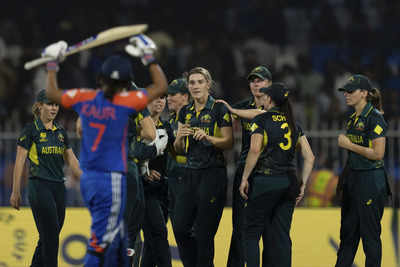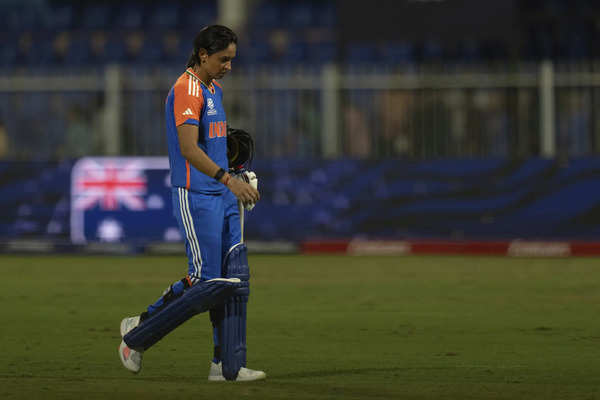[ad_1]

Once again, Australia women’s team got the better of India to clinch their third win in a row over the Women in Blue. Australia have won five of seven matches against India in Women’s T20 World Cup history. Fact that it came in a low-scoring thriller, with semi-final qualification on the line, made it an edge-of-the-seat affair.
In the end, though, as India fell nine-runs short, their quest to make it to the last-four were also taken from their hands.Instead, India women need Pakistan to beat New Zealand in order to have hopes of qualifying. If the White Ferns win, they progress and India will be sent packing.
It is not the first time India have been stopped short narrowly by Australia. During the 2022 Commonwealth Games gold medal match, chasing 162 to win, India were cruising at 118/2 and needed 44 from 33 balls.
Harmanpreet Kaur was motoring along and her 43-ball 65 had India in commanding position for the yellow metal and a huge win at the tournament.
Instead, India collapsed miserably to lose eight wickets for 34 runs to be bowled out for 152 runs and lose by nine runs.
Then there was the 2023 T20 World Cup semi-final. On that day in Cape Town, Australia posted 172/4 and India were once again in pole position for the win. India needed 41 from 34 balls and had six wickets in hand with Harmanpreet had struck 52 off 32 balls.
But then her bat got stuck in the most unfortunate of circumstances while sliding to complete a comfortable single. She walked off, in disgust, as India collapsed once again – losing four wickets and falling just five-runs shy of the target.
This time, Harmanpreet Kaur was there until the very end to try and overhaul the 152-run target. This time, though, India were not in a comfortable position as far as required run rate is concerned.
At 110/3, India needed 53 off 30 balls and then 42 runs from 26 balls. Not the biggest ask but not quite in the same league as the two heartbreaking defeats mentioned above.
Then, Deepti Sharma and Richa Ghosh fell in a matter of one run across four balls.

India’s captain Harmanpreet Kaur walks off the field after losing to Australia during the ICC Women’s T20 World Cup 2024 match at Sharjah Stadium. AP
Harmanpreet reduced the huge target to 14 runs to get in the last over. Having done the hard yards to bring her team close, the India skipper could not get them over the winning line as Annabel Sutherland struck twice in the final over coupled with two run outs to see Aussies into the semi-finals.
India started well in the powerplay, scoring 41 runs, but were pegged back with wickets coming at crucial stages to be 47/3. Smriti Mandhana, an explosive opener, scored six runs from 12 balls when she was required to step up to the new ball in a must-win game. With the surface getting slower as the match progressed and the task becoming tougher against the old ball, the onus was on the top order, including Harmanpreet, to play big from the word go.
Instead, when Jemimah Rodrigues fell, India entered a stage of boundary drought. For three straight overs, no boundaries came for India and the slowed down innings ensured Australia were through.
In desperate need for flow of runs, Harmanpreet pulled Darcie Brown in the 11th over, which was her first boundary and off the 15th ball she faced.
It took another 20 balls for India to clear the boundary rope again, in the 14th over, by which point the required run rate was above ten an over.
Harmanpreet almost single-handedly kept India in the hunt but the slowed down approach in the middle came back to hurt the team, despite a late push. The 35-year-old brought up her fifty off 44 balls but stood watching, haplessly, at the non-striker’s end for most of the final over, as wickets fell under pressure.
Later, a dejected Harmanpreet lauded an all-round Australia for chipping in while acknowledging they didn’t keep the scoring rate high enough.
“We knew this was (going to be) a difficult tournament,” Kaur said. “The only thing is, when Deepti and I were batting, that time we were not able to utilise a few loose balls. We could have controlled the boundaries. I think we were still in the game.
“I think their entire team contributes, they’re not dependent on one or two players,” she said.
“They know that they have so many all-rounders, they have batters who can take charge in the powerplay, and later on they don’t have anything fixed, they can always adjust according to pitch and situation.”
[ad_2]
Source link







